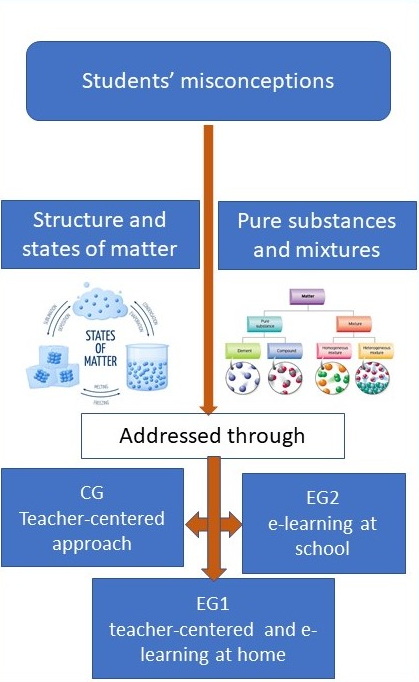The effects of e-learning units on 13-14-year-old students’ misconceptions regarding some elementary chemical concepts Scientific paper
Main Article Content
Abstract
Students’ misconceptions in science can lead to a range of learning difficulties if the teacher does not choose the appropriate teaching strategies to reduce their frequency. In this paper, 13–14-year-old students’ misconceptions regarding structure and states of matter, pure substances, and mixtures are explored. The teaching strategy with E-learning material was applied to examine its effects on the frequency of misconceptions. The research was conducted in urban schools in Bosnia and Herzegovina with 7th- and 8th-grade students. Findings pointed to the misconceptions originating in transferring the macroscopic observations into the submicroscopic level and in misinterpretation of the size of particles. Students who used E-learning material at school mostly had lower percentages of misconceptions in comparison to students from the control group and students who accessed the same E-learning material from their home. This indicates that the E-learning strategy could have promising results if applied more extensively at schools. This study aims to direct teachers’ attention toward applying E-learning in chemistry teaching, for students to gain scientifically accepted knowledge and to reduce the occurrence of misconceptions.
Downloads
Metrics
Article Details

This work is licensed under a Creative Commons Attribution-NonCommercial-NoDerivatives 4.0 International License.

Authors retain copyright and grant the journal right of first publication with the work simultaneously licensed under a Creative Commons Attribution license 4.0 that allows others to share the work with an acknowledgement of the work's authorship and initial publication in this journal.
References
A. H. Johnstone, J. Comput. Assist. Learn. 7 (1991) 75 (http://dx.doi.org/10.1111/j.1365-2729.1991.tb00230.x)
D. M. Bunce, in Sputnik to Smartphones: A Half-Century of Chemistry Education; ACS Symposium Series, M. V. Orna, Ed., American Chemical Society, New York, 2015, p. 107 (http://dx.doi.org/10.1021/bk-2015-1208.ch007)
D. D. Trivić, V. D. Milanović, J. Serb. Chem. Soc. 83 (2018) 1177 (http://dx.doi.org/10.2298/JSC171220055T)
T. A. Holme, C. J. Luxford, A. Brandriet, J. Chem. Educ. 92 (2015) 1477 (http://dx.doi.org/10.1021/acs.jchemed.5b00218)
S. M. Al-Balushi, I. S. Al-Harthy, Chem. Educ. Res. Pract. 16 (2015) 680 (http://dx.doi.org/10.1039/c5rp00052a)
H.-D. Barke, A. Hazari, S. Yitbarek, Misconceptions in chemistry: Addressing perceptions in chemical education, Springer-Verlag, Berlin, 2009
Y. J. Dori, J. Belcher, J. Learn. Sci.14 (2005) 243 (https://doi.org/10.1207/s15327809jls1402_3)
J. P. Smith, A. A. di Sessa, J. Roschelle, J. Learn. Sci.3 (1994) 115 (http://dx.doi.org/10.1207/s15327809jls0302_1)
M. I. Stojanovska, B. T. Soptrajanov, V. M. Petrusevski, Creat. Educ. 03 (2012) 619 (http://dx.doi.org/10.4236/ce.2012.35091)
N. Azizoglu, M. Alkan, Ö. Geban, J. Chem. Educ. 83 (2006) 947 (http://dx.doi.org/10.1021/ed083p947)
D. F. Treagust, R. Duit, Cult. Stud. Sci. Educ. 3 (2008) 297 (http://dx.doi.org/10.1007/s11422-008-9090-4)
A. G. Harrison, D. F. Treagust, in Chemical Education: Towards Research-Based Practice, Kluwer Academic Publishers, Dordrecht, 2003, p. 189 (http://dx.doi.org/10.1007/0-306-47977-X_9)
D. F. Treagust, A. L. Chandrasegaran, J. Crowley, B. H. W. Yung, I. P. A. Cheong, J. Othman, Int. J. Sci. Math. Educ. 8 (2010) 141 (http://dx.doi.org/10.1007/s10763-009-9166-y)
G. Papageorgiou, P. Johnson, Int. J. Sci. Educ. 27 (2005) 1299 (http://dx.doi.org/10.1080/09500690500102698)
B. Andersson, Stud. Sci. Educ. 18 (1990) 53 (http://dx.doi.org/10.1080/03057269008559981)
M. B. Nakhleh, A. Samarapungavan, Y. Saglam, J. Res. Sci. Teach. 42 (2005) 581 (http://dx.doi.org/10.1002/tea.20065)
V. Kind, Beyond appearances: Students’ misconceptions about basic chemical ideas, University of Durham, School of Education, Durham, 2004 (https://www.researchgate.net/publication/228799159_Beyond_Appearances_Students%27_Misconceptions_About_Basic_Chemical_Ideas)
R. J. Osborne, M. M. Cosgrove, J. Res. Sci. Teach. 20 (1983) 825 (http://dx.doi.org/10.1002/tea.3660200905)
K. Adbo, K. S. Taber, Int. J. Sci. Educ. 31 (2009) 757 (http://dx.doi.org/10.1080/09500690701799383)
M. Slapničar, I. Devetak, S. A. Glažar, J. Pavlin, J. Balt. Sci. Educ. 16 (2017) 308 (http://dx.doi.org/10.33225/jbse/17.16.308)
K. S. Taber, Teaching Secondary Chemistry, Hodder Education, London, 2012 (ISBN: 978-1444124323)
M. J. Sanger, J. Chem. Educ. 77 (2000) 1517 (https://doi.org/10.1021/ed077p762)
J. Olson, J. Codde, K. deMaagd, E. Tarkelson, J. Sinclair, S. Yook, R. Egidio, An Analysis of E-Learning Impacts & Best Practices in Developing Countries with Reference to Secondary School Education in Tanzania, The ICT4D Program, Michigan State University, East Lansing, MI, 2011. (https://www.researchgate.net/publication/272682458_An_Analysis_of_e-Learning_Impacts_Best_Practices_in_Developing_Countries_With_Reference_to_Secondary_School_Education_in_Tanzania)
E. Ural, O. Ercan, J. Balt. Sci. Educ. 14 (2015) 7 (http://dx.doi.org/10.33225/jbse/15.14.07)
N. Rizman Herga, B. Čagran, D. Dinevski, Eurasia J. Math. Sci. Technol. 12 (2016) (http://dx.doi.org/10.12973/eurasia.2016.1224a)
N. Rizman Herga, S. A. Glažar, D. Dinevski, J. Balt. Sci. Educ. 14 (2015) 351 (http://dx.doi.org/10.33225/jbse/15.14.351)
S. A. Glažar, Snovi so iz delcev http://www.kii3.ntf.uni-lj.si/e-kemija/uenota.php?a=sglazar&e=snovi_so_iz_delcev, accessed September 14, 2022 (in Slovenian)
S. A. Glažar, Čiste snovi in zmesi http://www.kii3.ntf.uni-lj.si/e-kemija/mod/resource/view.php?id=286, accessed September 14, 2022 (in Slovenian)
H. S. Dhinsda, D. F. Treagust, Brunei Int. J. Sci. Math. Educ. 1 (2009) 33 (https://shbieejournal.files.wordpress.com/2009/11/hsddavideditedpdf.pdf)
D. D. Milenković, T. N. Hrin, M. D. Segedinac, S. Horvat, J. Subj. Didact. 1 (2016) 3 (http://dx.doi.org/10.5281/zenodo.55468)
K. S. Taber, Res. Sci. Educ. 48 (2018) 1273 (http://dx.doi.org/10.1007/s11165-016-9602-2)
J. K. Gilbert, Res. Sci. Educ. 7 (1977) 165 (https://doi.org/10.1007/BF02643123)
M. G. Jones, A. R. Taylor, J. Res. Sci. Teach. 46 (2009) 460 (http://dx.doi.org/10.1002/tea.20288)
T. R. Tretter, M. G. Jones, J. Minogue, J. Res. Sci. Teach. 43 (2006) 1061 (http://dx.doi.org/10.1002/tea.20155)
D. Özalp, A. Kahveci, Chem. Educ. Res. Pract. 16 (2015) 619 (http://dx.doi.org/10.1039/c5rp00096c)
G. M. Bodner, J. Chem. Educ. 68 (1991) 385 (https://doi.org/10.1021/ed068p385)
D. Sharpe, Pract. Assess. Res. Evaluation 20 (2015) 1 (http://dx.doi.org/10.7275/tbfa-x148)
F. Canada, R. Alvarez, M. J. Arevalo, M. V. Gill, J. Cubero, L. Ortega, in Conference proceedings of the 5th International Conference on Education, Research and Innovation – ICERI2012 (2012), Madrid, Spain, International Academy of Technology, Education and Development (IATED), Valencia, 2012, p. 4598
B. Costu, S. Ünal, A. Ayas, J. Balt. Sci. Educ. 6 (2007) 35 (http://oaji.net/articles/2014/987-1404286868.pdf)
R. Martín del Pozo, P. Galán Martín, Revista Eureka Sobre Enseñanza y Divulgación de Las Ciencias 9 (2012) 213 (https://revistas.uca.es/index.php/eureka/article/view/2768/2416)
F. C. Cañada, D. Gonzalez-Gomez, L. V. Melo Niño, A. Acedo Dávila, Int. Electron 9 (2017) 499 https://www.researchgate.net/publication/313986987
G. Papageorgiou, D. Sakka, Educ. Res. Pract. Eur. 1 (2000) 237 (http://dx.doi.org/10.1039/A9RP90025J)
J. L. Kuethe, Sci Educ 47 (1963) 361 (http://dx.doi.org/10.1002/sce.3730470410)
G. I. Za’Rour, J. Res. Sci. Teach. 12 (1975) 385 (http://dx.doi.org/10.1002/tea.3660120409)
M. Stein, T. G. Larrabee, C. R. Barman, J. Elem. Sci. Educ. 20 (2008) 1 (http://dx.doi.org/10.1007/BF03173666).





